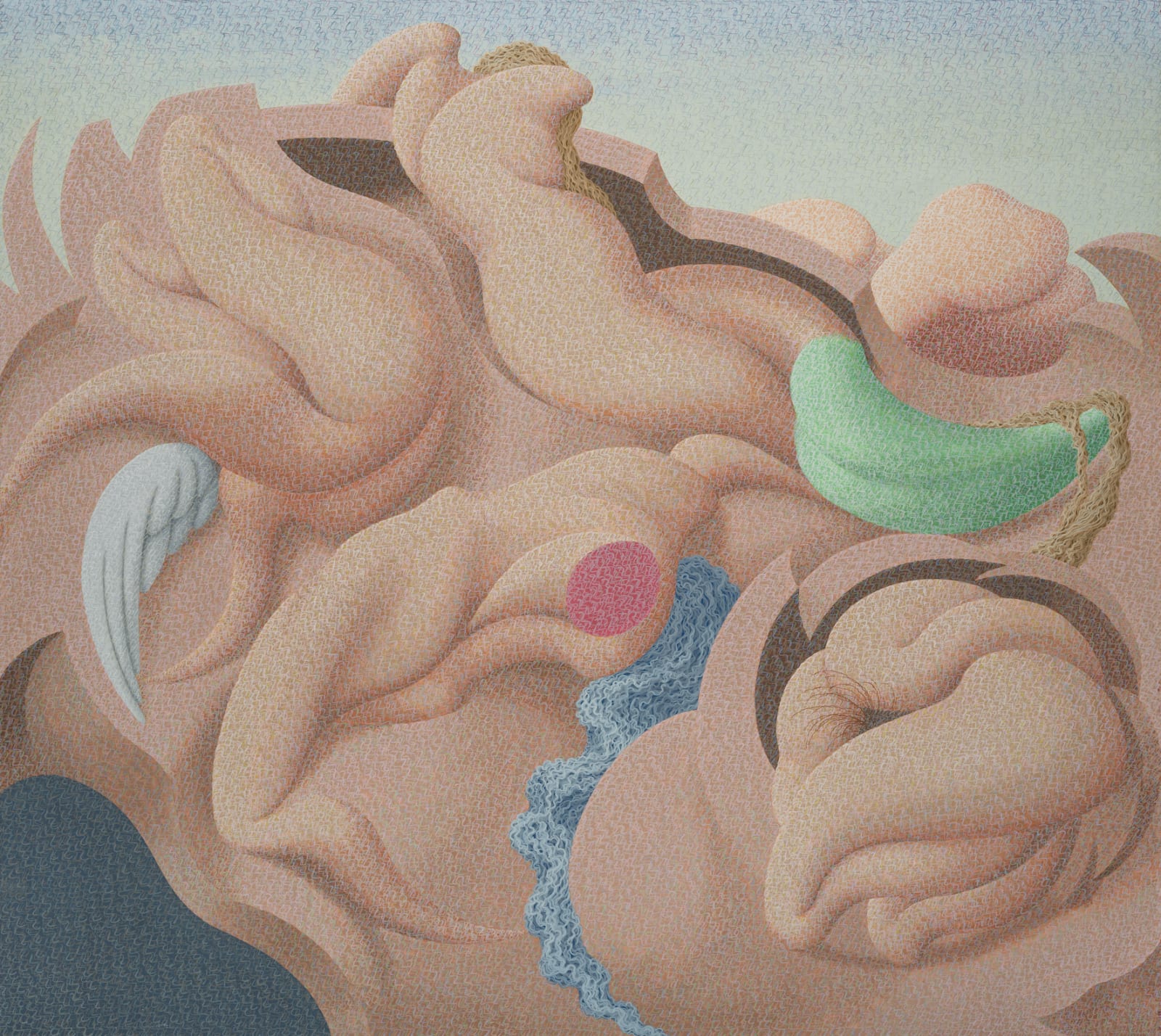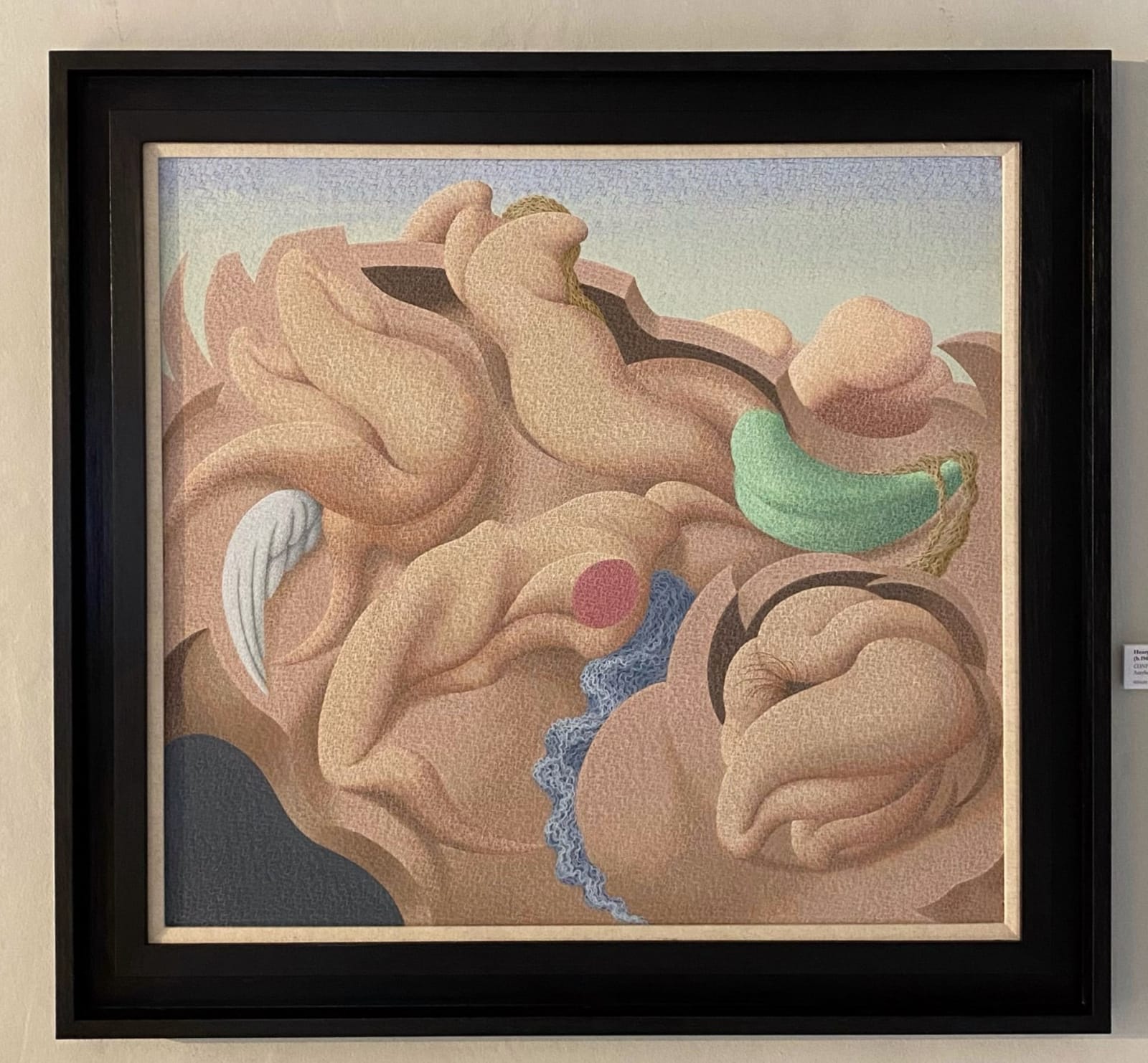Henry Orlik b. 1947
With artist's stamp on verso
Further images
Confusion appears to be a beach-scape comprised of a mass of bodies and body parts, convoluted and writhing, like soft-rocks in a landscape. In Orlik’s creative imagination, he transforms the scene from a commonplace beach scene into something metaphysical and physical so that shoulders and arms become angel wings, a leg and foot become a green tongue, shapes like rumpled sunhats appear on the horizon and complex shapesconverge in a round, nut-like structure suggestive of shoulders, legs and behind and a head of hair which also becomes an eye or an anus. It is a confusion of bodies and shapes.
In Orlik’s quantum world, (and as with his Surreal Landscape which could be seen to be a depiction of a cell and all its internal workings) the structure turns into a giant cell and all the cell parts become body parts. Similarly, the structure ingeniously becomes a cross-section of a brain and this conjures images of Michelangelo’s Creation of Adam in the Sistine Chapel in which God lies within a giant brain as he reaches towards Adam while bodies entwine behind Him. Orlik uses the same colouration (the soft skin colours and the green flowing scarf which drifts below God, is the same green as Orlik’s leg/tongue). Michelangelo painted hidden internal organs in the Chapel at a time when dissection of bodies was carried out in secret. The Creation of Adam conveys the idea of creation rooted in wisdom, which stems from the ‘brain’ of God. In the Kabbalah, the Mochah Stima’ah is the hidden brain, ‘the mysterious facet of God’ and is also ‘the unknown purpose behind the will to create. This ‘hidden brain’ (also known as ‘concealed wisdom’) inspires in human beings the will to create, to build, to design, … to sculpt to paint.’ (Benjamin Blech and Roy Doliner, Michelangelo’s Forbidden Messages in the Heart of the Vatican, 2008, pp. 200-201). Confusion, thus, becomes an expression of Orlik’s own ceaseless will to create his art.
In Confusion, the body parts and bodies become recognisable parts of the brain: the cerebrum, the cerebellum, the occipital lobe, the cortex; the blue/grey net becomes the brain stem. The cerebellum is the circular part on the right of the painting, made up of an entangled circle of body parts. The cerebellum receives input from sensory systems of the spinal cord; it produces fine movement (such as the ability to paint Orlik’s ‘excitations’ brushwork), equilibrium and motor learning and controls cognitive functions such as attention and language as well as emotional control such as regulating fear and pleasure responses.
The seemingly out of place, prominent pink circle could be the thalamus which controls information from the body's senses which must be processed before being sent to thebrain's cerebral cortex for interpretation. It plays a role in sleep, wakefulness, consciousness, learning and memory and connects the two cerebral hemispheres. Perhaps, more significantly, it could replicate the pineal gland which René Descartes (the 17th-century French philosopher) famously referred to as the ‘principal seat of the soul’; in more modern contexts, the pineal gland is often dubbed the ‘third eye’ due to its perceived connection to spiritual experiences and intuition.
If Confusion can be seen as a modern development of Michelangelo’s ‘brain’ of God, the pink circle also becomes the absence of God – the ‘God-shaped hole’ in an atheist society. The pink is a stronger, condensed version of the pink of God’s robe in the Sistine Chapel. Similarly, the blue/grey ‘netting’ becomes God’s unravelled beard, as he is ‘let go’ by a culture. The top figure becomes the woman on the right of God, who he seems to restrain with his strong arm. Tradition sees this figure as either Eve or Sophia (Wisdom). In Orlik’s painting, she is now freed and has made her way to the top of the painting and peers over the edge, her shoulders hunched up behind, shaped like angel-wings (which are also reminiscent of vulture’s wings – perhaps like a siren). Her golden hair in Michelangelo’s painting is piled on her head, in Orlik’s, her long hair is let loose, abandoned and carefree and flows down to entwine with her foot/green tongue. Loosened hair is often a symbol of wantonness or the abandonment of morals. If she represents Eve, then she potentially, in historic interpretations, becomes a temptress figure and her leg becomes the green tongue of the serpent who entices her and Adam to eat the forbidden fruit. In Orlik’s depiction, she also becomes a mermaid or Melusine and the green tongue becomes a mermaid’s fish tail. The Melusine is sometimes illustrated with wings, two tails or both. She is seen as a fertility figure or, like a mermaid or lamia, as a femme fatale figure who entices men to their destruction. In this context, the ‘sunhat’ on the horizon morphs into the buttocks of a figure that is already disappearing over (diving off) the edge of the ‘brain’, and it appears that she will snake her way over the top of the ‘brain’ too.
Orlik’s ‘excitations’ brushwork is interesting in the context of Confusion. He was greatly influenced by the writing of Danah Zohar and her work on quantum physics. In a pertinent paragraph of her book, The Quantum Self, (1990, p.212), she wrote:
‘Stephen Hawking has said that if we were to discover a complete theory of cosmology, we might come to know the mind of God [Stephen Hawking, A Brief History of Time, Bantam, 1988, p. 175]. (I would suggest that if we truly understand our place in the evolving universe, we might come to see ourselves as thoughts (excitations) in the mind of God. In some very important sense, each of us lives his life within a cosmic context.’In this ‘chain of evolving consciousness. Things emerge as fluctuations (excitations) in the vacuum, grow towards renewed coherence, and return to the vacuums as ‘enriched’ fluctuations.’ (The Quantum Self, 1990, pp. 210-211). Thereby, Orlik’s excitation brushwork becomes manifestations of his thoughts, which are cosmic thoughts, and in our collective consciousness, are also our thoughts. This confusion of thoughts (the swirls of brushstrokes) is a process that must be passed through in order to come to a conclusion or epiphany – to the moment of inspiration. As Nietzsche wrote: ‘You must carry a chaos inside you to give birth to a dancing star’.
Furthermore, Pierre Teilhard de Chardin (the twentieth century mystic and evolutionary scientist) ‘seeks to link the evolution of mind with the concept of energy’. Sir Julian Huxley (in the introduction to The Phenomenom of Man) understands him to interpretthis as ‘two forms of energy’: ‘energy in the physicists’ sense, measurable or calculable by physical methods, and ‘psychic energy’ which increases with the complexity of organised units’. (Pierre Teilhard de Chardin, The Phenomenom of Man, 1972 (first published 1955), pp. 16-17). This coincides with the idea of ‘coherent vibrations’ which are ‘excited in biological systems through the supply of energy’ (proposed by H. Fröhlich and F. Kremer (eds), Coherent Excitations in Biological Systems, Springer-Verlag, 1983) which like Orlik’s excitations become Teilhard’s ‘organised web of thought’ (Pierre Teilhard de Chardin, The Phenomenom of Man, 1972 (first published 1955), p. 18).












